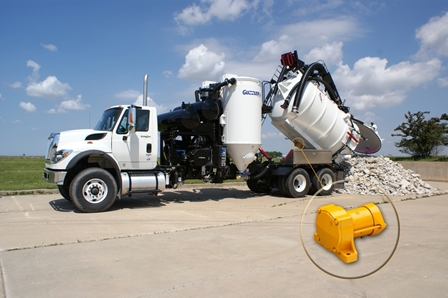Martin Products Improve Material Handling At Vactor Manufacturing
Publicado: June 15th 2012
 [Peru, IL] -- One of the world’s leading manufacturers of industrial vacuum loaders, hydro excavators and sewer cleaners is employing engineered vibration technology to improve off-loading of industrial waste, including difficult materials such as dry bulk powders, slurries and even thick sludge. The ability to quickly and completely evacuate the debris hopper raises productivity, while avoiding the need for worker intervention to successfully empty the entire load. The effectiveness of the technology from Martin Engineering’s Cougar® line of vibrators is so well recognized that every industrial vacuum loader is specified with a 12V unit installed as standard equipment.
[Peru, IL] -- One of the world’s leading manufacturers of industrial vacuum loaders, hydro excavators and sewer cleaners is employing engineered vibration technology to improve off-loading of industrial waste, including difficult materials such as dry bulk powders, slurries and even thick sludge. The ability to quickly and completely evacuate the debris hopper raises productivity, while avoiding the need for worker intervention to successfully empty the entire load. The effectiveness of the technology from Martin Engineering’s Cougar® line of vibrators is so well recognized that every industrial vacuum loader is specified with a 12V unit installed as standard equipment.
Since the 1960s, Vactor Manufacturing (Streator, IL) has combined expertise in pneumatics and high-pressure water technology to design and manufacture its patented vacuum loaders and combination sewer cleaners for the municipal public works and industrial markets. The truck-mounted Vactor® brand sewer cleaning units are designed to remove obstructions from clogged lines, culverts and catch basins, while the Guzzler® industrial loaders have found broad utility in cement plants, steel mills, refineries, chemical plants and power generating stations.
Vactor is also an innovator in high-performance hydro excavators, a safe, highly productive and non-destructive excavation method. To suit the wide range of applications for its mobile units, the company builds every machine to order, based on customer specs.
“In these industrial applications, our customers could be dealing with fly ash, cement, sand, liquids or thick sludge,” explained Product Manager Brett Hart. “You might think of these units as giant shop vacs, used when other equipment can’t access a site. Operators can run the hose hundreds of feet to reach difficult locations and remove material.”
Hart said that the debris hoppers on the hydro excavators and vacuum loaders have a dump mechanism that rises to a 50º angle for offloading, but often the contents resist emptying. “The vibrator allows the operator to flip a switch and break the surface tension, quickly evacuating the material,” he continued. “It reduces offloading and clean-up time, and also helps avoid the temptation for personnel to intervene in an effort to extract the entire contents.”
Although Vactor uses four different vibrator models for various applications in its vacuum loaders and hydro excavators, all are from Martin’s Cougar® product line. Each industrial truck gets a mounting plate, whether ordered with a vibrator or not, so a retrofit is an easy bolt-on installation.
Three of the Cougar® models are heavy-duty electric units, such as the DC-3200, a powerful design that’s well suited to dump trucks with a capacity of 10-15 yards, live-bottom tandem dump trucks that carry 15-30 yards, as well as large spreaders and vacuum trucks. It delivers 4,000 vibration cycles per minute (VPM) with 3,200 pounds of force, while drawing just 85 amps from the 12V model and 62 amps from the 24V version.
The fourth model is hydraulic, for customers who prefer that option. The HA4-3300 is a variable-speed unit with adjustable eccentrics. Capable of 4,500 VPM with 3,278 pounds of force, the motor is designed for minimal power consumption and low maintenance. Developed to create more force per size/weight, it’s suitable for continuous duty or intermittent work.
Partnering In Cost Reduction
The two companies have a relationship that spans two decades, working together on solutions for new products or specific applications. “Martin Engineering and their Cougar® products have earned their place as a valued partner with us,” Hart said. “When we have material challenges, they review the details with us and make recommendations, sometimes giving us several models that we can test under field conditions. So our equipment is fitted with the best possible solution for a customer’s specific application.”
An example of that partnering concept came during recent cost reduction efforts by Vactor officials. Because the company provides its own mounting base and some wiring for the vibrator installations, they contacted Martin Engineering to ask if certain elements of the standard installation kit could be eliminated to trim expenses.
Together the two firms reviewed the bill of materials for all four vibrator models currently in use by Vactor, identifying any parts that weren’t being used. By eliminating those components, Vactor maximizes its investment and saves an estimated $40 per unit.
“Over time, that savings is significant,” Hart concluded. “The type of vendor/OEM relationship we’ve developed with Martin is critical to delivering the best value and product to our customers,” Hart added. “Anyone can sell you a vibrator.”